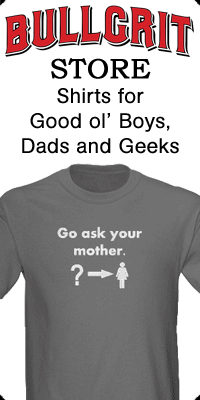 As a birthday present, I just received a copy of the classic Dungeons & Dragons “basic” edition game rule book edited by Eric Holmes. This edition of the game was intended to be an introduction to the overall game of Dungeons & Dragons, and a stepping stone to the Advanced Dungeons & Dragons edition of the game. The first, original edition of D&D was published in 1974, the advanced edition in 1978-1979*, and this basic introduction in 1978.
As a birthday present, I just received a copy of the classic Dungeons & Dragons “basic” edition game rule book edited by Eric Holmes. This edition of the game was intended to be an introduction to the overall game of Dungeons & Dragons, and a stepping stone to the Advanced Dungeons & Dragons edition of the game. The first, original edition of D&D was published in 1974, the advanced edition in 1978-1979*, and this basic introduction in 1978.
The preface says, (caps and bold as in the book):
This book is based upon the original work published in 1974 and three supplementary booklets published in the two year period after the initial release of DUNGEONS & DRAGONS. It is aimed solely at introducing the reader to the concepts of fantasy role playing and the basic play of this game. To this end it limits itself to basics. The rules contained herein allow only for the first three levels of player progression, and instructions for the game referee, the “Dungeon Master,” are kept to the minimum necessary to allow him to conduct basic games. This is absolutely necessary because the game is completely open-ended, is subject to modification, expansion, and interpretation according to the desires of the group participating, and is in general not bounded by the conventional limitations of other types of games. This work is far more detailed and more easily understood than were the original booklets nonetheless, for with it, and the other basic components of the game, any intelligent and imaginative person can speedily understand and play DUNGEONS & DRAGONS as it was meant to be played. Players who desire to go beyond the basic game are directed to the ADVANCED DUNGEONS & DRAGONS books.
I was introduced to D&D through the Basic Dungeons & Dragons rules edited by Tom Moldvay, published in 1981. The Moldvay edition was a revising of the Holmes edition, but instead of being a “gateway” into Advanced D&D, it lead to Expert D&D. Yeah, it’s confusing; see the last sentence of the footnote below. Anyway, I only mention this to explain that although I played “Basic D&D” in my earliest days of gaming, it was a different “basic” than this edition I’m reviewing here. I’ve always been interested to see and read the Holmes edition of this game, but the books are relatively rare.
The thing that sticks out most to me with the text of this game rule book is how so very verbose and convoluted everything is. I’m fluent in the complicated rules of Advanced D&D, (and they are very complicated, and spread out through two poorly organized books), but reading these rules in this basic version of the game makes my head throb. Not only are they written in verbose paragraphs, and scattered unorganized through the book, but many of the rules are just very badly designed. For instance, check out this bit of text, (with apologies for my poor scan):

First off, for ease of reading and understanding that first part should not be one wall-of-text paragraph. Now, as for the rules, earlier in the book it is explained that all weapons do 1d6 damage. (For variable damage, you are directed to the AD&D books.) So, a dagger and a battle axe do the same amount of hit point damage. But you can attack twice in a round with a dagger, and only once every other round with an axe — that comes to dagger has 4 (1d6 damage) attacks to the axe 1 (1d6 damage) attack. That’s absurd. That’s either extremely poor game design or some sorry editing work. And this isn’t just a cherry-picked section. The whole book is riddled with crazy stuff like this.
The section on magic weapons says that magic swords add their bonus to attack rolls, but not to damage rolls. Unless that sword has a bonus for certain types of creatures (like a “Sword +1, +2 against Lycanthropes”), in which case the bonus gets added to damage against that particular creature, (like lycanthropes). But magic weapons other than swords add their bonus to attack rolls and damage rolls. That is: a sword +1 adds +1 to the attack roll but not the damage roll, (once a round); but a dagger +1 adds +1 to the attack roll and the damage roll, (twice a round).
Let’s even go back to the beginning of the book and look at how this all starts out. The text explains that character ability scores are created by rolling 3d6 to generate a number from 3-18. Then each ability score is given a paragraph of explanation. But the numbers, (3-18), don’t give any bonus or penalty beyond experience point adjustments. Although the text says, “… a character with a strength of 18 would be super-powerful, one with a strength of 3 (lowest possible dice roll) would barely be able to lift his sword off the ground,” there is no actual mechanical difference between the two characters. Other than an experience point bonus/penalty, there is no game mechanic difference between 18 strength and 3 strength. They both still use the same attack numbers, same damage numbers, and can carry the same amount of weight, (treasure and equipment), by the rule mechanics. It’s the same with Intelligence, Wisdom, and Charisma. Only Constitution, (-1 to +3 hit points per hit die), and Dexterity, (-1 to +1 missile fire adjustment), have any game mechanic difference for the number assigned to them. This leaves me wondering, “Why?”
Reading all this stuns me. These are some horribly written rules. It’s not like the designer(s) missed something, or forgot something, they directly state most of this insanity. And for a “basic” and “introductory” set of rules, the text is ridiculously verbose and convoluted. I grew up in gaming with the Advanced D&D rules, (after beginning with the Moldvay Basic D&D game), so I’m used to the intricacies of a complicated game system. But this Holmes edition is bad. Really bad. Childishly bad. The text reads like it was written by a 15 year old trying to impress the reader with his vocabulary while padding out the page count. The rules seem to be developed on the fly, in a stream of consciousness method, without any play testing or second reading.
An interesting note, though, outside the terrible rules and writing: the concept and use of miniature figures on the table top is mentioned throughout the pages of these rules. A big complaint by “old school” D&D players about the modern D&D game, (starting with third edition published in 2001), is that the game today assumes and “forces” the players to use miniature figures. But this rule book from 1978 assumed and guided the use of such figures even then. (I used miniature figures from my earliest days of gaming because the rules I read, like in this book, directed me to use them.)
Overall, I’m really surprised, (in a bad way), by this book. I can’t say I’m “disappointed,” because I didn’t get this book to entertain me. I got this book just to read an integral part of D&D’s publishing history. But I am surprised at how poorly designed and written it is as a game, and I’m astonished that this amateurish piece of confusion got published as a “basic” and “introductory” version of the game that eventually grew into the cultural phenomenon it did. As complicated as the Advanced D&D edition is, (in concept, in rules, in organization, and in publishing pattern), it made more sense than this introduction. And the Moldvay Basic D&D edition is by far a better written, edited, organized, and designed “basic” game than this version. And note that this review I’ve written, here, doesn’t even scratch the surface of what all is in this book. This Holmes edition of the D&D game is just awful throughout, every section, every page, every paragraph. Just abysmal.
Bullgrit
* The Advanced Dungeons & Dragons Monster Manual was first published in 1977, but it was only a book of monsters, not a book of rules. The AD&D Player’s Handbook was first published in 1978, and although it actually contained game rules, it didn’t contain everything one needed to play AD&D, (it didn’t even have rules for creating a character). The AD&D Dungeon Master’s Guide was first published in 1979, and with it players at last had the full game rules for playing the advanced version of the game. The early days of D&D publishing was a bit schizophrenic and confusing, and it’s a remarkable study to figure how the game managed to grow despite that mess.






 Categories:
Categories: 


 As a birthday present, I just received a copy of the classic Dungeons & Dragons “basic” edition game rule book edited by Eric Holmes. This edition of the game was intended to be an introduction to the overall game of Dungeons & Dragons, and a stepping stone to the Advanced Dungeons & Dragons edition of the game. The first, original edition of D&D was published in 1974, the advanced edition in 1978-1979*, and this basic introduction in 1978.
As a birthday present, I just received a copy of the classic Dungeons & Dragons “basic” edition game rule book edited by Eric Holmes. This edition of the game was intended to be an introduction to the overall game of Dungeons & Dragons, and a stepping stone to the Advanced Dungeons & Dragons edition of the game. The first, original edition of D&D was published in 1974, the advanced edition in 1978-1979*, and this basic introduction in 1978.








